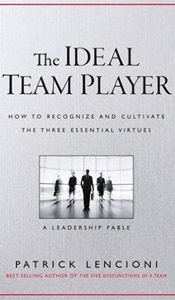Happy, Hungry, Smart
Review of 'The Ideal Team Player' by Patrick Lencioni
 Patrick Lencioni, The Ideal Team Player: How to Recognize and Cultivate the Three Essential Virtues: A Leadership Fable (Hoboken, NJ: Jossey-Bass, 2016).
Patrick Lencioni, The Ideal Team Player: How to Recognize and Cultivate the Three Essential Virtues: A Leadership Fable (Hoboken, NJ: Jossey-Bass, 2016).
Effective organizations—whether they’re multinational corporations, professional sports franchises, or local churches—practice teamwork. When people work together on a common goal, they achieve more than they could do individually and experience a measure of personal satisfaction. When people work against one another, however, the result is organizational ineffectiveness and personal frustration.
In his 2002 bestseller, The Five Dysfunctions of a Team, Patrick Lencioni outlined five ways teamwork goes awry: absence of trust, fear of conflict, lack of commitment, avoidance of accountability, and inattention to results. While that book identified the interpersonal dynamics of effective teams, it did not identify the personal qualities of effective team members. Lencioni’s new book, The Ideal Team Player, picks up where Five Dysfunctions left off and outlines three essential “virtues”: An ideal team member is humble, hungry, and smart.
Humility comes first because it is “the single greatest and most indispensable attribute of being a team player.” Humble team players are not “overtly arrogant,” of course, but they do not “lack self-confidence” either. Rather, quoting C. S. Lewis, Lencioni writes, “Humility isn’t thinking less of yourself, but thinking of yourself less.” Humility makes collective action possible. Without it, teams don’t work effectively, because each member is either out for themselves ( due to overt arrogance) or unable to propose solutions (because of lack of self-confidence).
Effective organizations—whether they’re multinational corporations, professional sports franchises, or local churches—practice teamwork.
“Hungry people are always looking for more,” writes Lencioni. They are “self-motivated and diligent.” For a team to work effectively, each team member must proactively contribute to the overall effort. No slackers are allowed.
Smart doesn’t pertain to “intellectual capacity,” though it’s similar to emotional intelligence. Lencioni defines it as “a person’s common sense about people…the ability to be interpersonally appropriate and aware.” Ideal team members are people-smart.
After defining these three virtues, Lencioni outlines why and how they must work together. “If even one is missing in a team member, teamwork becomes significantly more difficult and sometimes not possible.” A team member who is only humble and hungry, for example, becomes an “accidental mess-maker” because they are constantly—albeit unintentionally—stepping on others’ toes. One who is only humble and smart is a “lovable slacker,” liked by all, but only willing to exert minimum necessary effort. Someone who is only hungry and smart is a “skillful politician,” which Lencioni describes as being “cleverly ambitious and willing to work extremely hard, but only in as much as it will benefit them personally.”
Although Lencioni wrote The Ideal Team Playerfor the secular business world, my description of its contents should convince ministers that it has application to the work of local churches as well. (Indeed, Lencioni—a devout Catholic—notes that Jesus Christ is the “most compelling example of humility in the history of mankind.”) The humble-hungry-smart model gives senior pastors and ministers who lead volunteers valuable insights into who to hire, how to assess their performance, what can be done to develop them when they lack one or more of the virtues, and how to embed those virtues in a church’s organizational culture. Consequently, I highly recommend this book to ministers and ministry leaders.
One final note: As with The Five Dysfunctions of a Team, The Ideal Team Player begins with what Lencioni calls “a leadership fable.” He tells the story of the CEO of a family-owned building company who discovers these three virtues in the course of taking over the reins of the company from his uncle. Only after telling the fable does Lencioni describe the humble-hungry-smart model in propositional terms. This narrative way of approaching the subject shows before it tells. This makes Lencioni’s points concrete and easy to understand. The show-then-tell approach is also, it seems to me, a great way to preach…though that is a subject for another time.
Influence Magazine & The Healthy Church Network
© 2025 Assemblies of God

